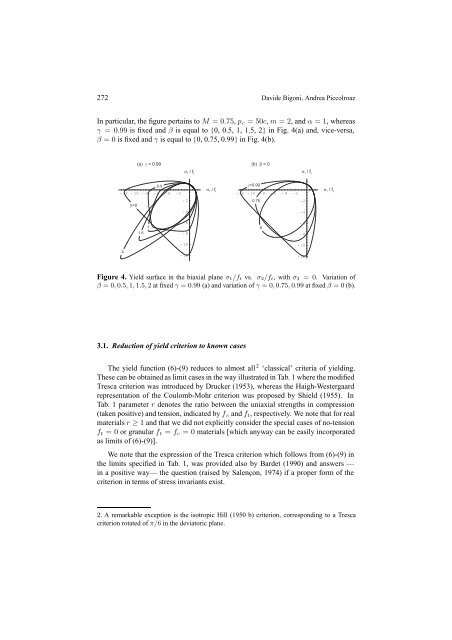A new yield function for geomaterials. - Ingegneria - Università degli ...
A new yield function for geomaterials. - Ingegneria - Università degli ...
A new yield function for geomaterials. - Ingegneria - Università degli ...
Create successful ePaper yourself
Turn your PDF publications into a flip-book with our unique Google optimized e-Paper software.
272 Davide Bigoni, Andrea Piccolroaz<br />
In particular, the figure pertains to M =0.75, pc =50c, m =2, and α =1, whereas<br />
γ =0.99 is fixed and β is equal to {0, 0.5, 1, 1.5, 2} in Fig. 4(a) and, vice-versa,<br />
β =0is fixed and γ is equal to {0, 0.75, 0.99} in Fig. 4(b).<br />
=0<br />
(a) = 0.99<br />
(b) = 0<br />
0.5<br />
- 12 - 10 - 8 - 6 - 4 - 2<br />
2<br />
1.5<br />
1<br />
/f t<br />
- 2<br />
- 4<br />
- 6<br />
- 8<br />
- 10<br />
- 12<br />
1 /f t<br />
=0.99<br />
- 12 - 10 - 8 - 6 - 4 - 2<br />
Figure 4. Yield surface in the biaxial plane σ1/ft vs. σ2/ft, with σ3 = 0. Variation of<br />
β =0, 0.5, 1, 1.5, 2 at fixed γ =0.99 (a) and variation of γ =0, 0.75, 0.99 at fixed β =0(b).<br />
3.1. Reduction of <strong>yield</strong> criterion to known cases<br />
The <strong>yield</strong> <strong>function</strong> (6)-(9) reduces to almost all 2 ‘classical’ criteria of <strong>yield</strong>ing.<br />
These can be obtained as limit cases in the way illustrated in Tab. 1 where the modified<br />
Tresca criterion was introduced by Drucker (1953), whereas the Haigh-Westergaard<br />
representation of the Coulomb-Mohr criterion was proposed by Shield (1955). In<br />
Tab. 1 parameter r denotes the ratio between the uniaxial strengths in compression<br />
(taken positive) and tension, indicated by f c and ft, respectively. We note that <strong>for</strong> real<br />
materials r ≥ 1 and that we did not explicitly consider the special cases of no-tension<br />
ft =0or granular ft = fc =0materials [which anyway can be easily incorporated<br />
as limits of (6)-(9)].<br />
We note that the expression of the Tresca criterion which follows from (6)-(9) in<br />
the limits specified in Tab. 1, was provided also by Bardet (1990) and answers —<br />
in a positive way— the question (raised by Salençon, 1974) if a proper <strong>for</strong>m of the<br />
criterion in terms of stress invariants exist.<br />
2. A remarkable exception is the isotropic Hill (1950 b) criterion, corresponding to a Tresca<br />
criterion rotated of π/6 in the deviatoric plane.<br />
0.75<br />
0<br />
- 10<br />
- 12<br />
/f t<br />
- 2<br />
- 4<br />
- 6<br />
- 8<br />
1 /f t
















